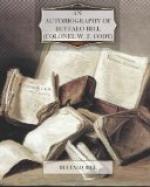I had killed fifteen buffaloes, and we were on our way home with a wagonload of meat when we were jumped by a big band of Indians.
[Illustration: Winning my name—“Buffalo Bill”]
I was mounted on a splendid horse belonging to the company, and could easily have made my escape, but Scotty had only the mule team, which drew the wagon as a means of flight, and of course I could not leave him.
To think was to act in those days. Scotty and I had often talked of what we would do in case of a sudden attack, and we forthwith proceeded to carry out the plan we had made.
Jumping to the ground, we unhitched the mules more quickly than that operation had ever been performed before. The mules and my horse we tied to the wagon. We threw the buffalo hams on the ground and piled them about the wheels so as to form a breastwork. Then, with an extra box of ammunition and three or four extra revolvers which we always carried with us, we crept under the wagon, prepared to give our visitors a reception they would remember.
On came the Indians, pell-mell, but when they got within a hundred yards of us we opened such a sudden and galling fire that they held up and began circling about us.
Several times they charged. Their shots killed the two mules and my horse. But we gave it to them right and left, and had the satisfaction of seeing three of them fall to the ground not more than fifty feet away.
When we had been cooped up in our little fort for about an hour we saw the cavalry coming toward us, full gallop, over the prairie. The Indians saw the soldiers almost as soon as we did. Mounting their horses, they disappeared down the canon of the creek. When the cavalry arrived we had the satisfaction of showing them five Indians who would be “good” for all time. Two hours later we reached the camp with our meat, which we found to be all right, although it had a few bullets and arrows imbedded in it.
It was while I was hunting for the railroad that I became acquainted with Kit Carson, one of the most noted of the guides, scouts, and hunters that the West ever produced. He was going through our country on his way to Washington. I met him again on his return, and he was my guest for a few days in Hays City. He then proceeded to Fort Lyon, Colorado, near which his son-in-law, Mr. Boggs, resided. His health had been failing for some time, and shortly afterward he died at Mr. Boggs’s residence on Picket Wire Creek.
Soon after the adventure with Scotty I had my celebrated buffalo shooting contest with Billy Comstock, a well-known guide, scout, and interpreter. Comstock, who was chief of scouts at Fort Wallace, had a reputation of being a successful buffalo hunter, and his friends at the fort—the officers in particular—were anxious to back him against me.
It was arranged that I should shoot a match with him, and the preliminaries were easily and satisfactorily arranged. We were to hunt one day of eight hours, beginning at eight o’clock in the morning. The wager was five hundred dollars a side, and the man who should kill the greater number of buffaloes from horseback was to be declared the winner. Incidentally my title of “Buffalo Bill” was at stake.




